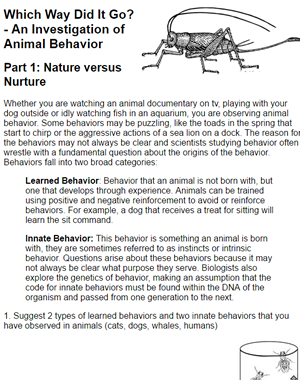
This case study builds upon a traditional AP Biology lab on animal behavior where students design an experiment to text taxis is pillbugs. Instead of a stand-alone lab, this case study investigates historic experiments on animals that ask questions about whether behavior is learned or innate.
The goal is for students to develop a basic understanding about how animal models are used to study behavior and how behavior can be explained from an evolutionary perspective.
Students even revisit the chi square equation and the null hypothesis to determine if data show a true preference toward a stimulus.
Students learn about feedback mechanisms, and positive and negative taxis, finally culminating in an experiment they design to investigate whether an animal model exhibits taxis toward a stimuli.
Students can use pillbugs they collect outside or use animals raised in the classroom, like mealworms or Dubia roaches. Choice chambers can be purchased or students can design their own.
A shorter form is this lab is available that is more specific for using isopods and includes a chi square analysis.
Grade Level: 11-12 | Time Required: 2-3 Hours
HS-LS1-3 Plan and conduct an investigation to provide evidence that feedback mechanisms maintain homeostasis.
HS-LS2-8 Evaluate the evidence for the role of group behavior on individual and species’ chances to survive and reproduce.

